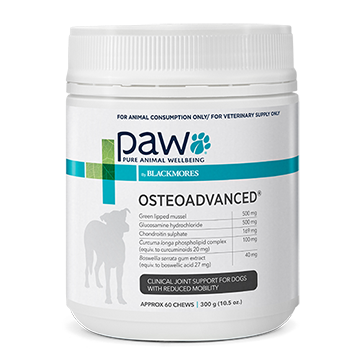
- A Guide To Perfect Your Pet's Health/
- Health and Vitality Products For Your Dog/
- How To Identify and Treat Pain In Dogs


When humans are in pain, you usually know about it. We cry out, complain, limp about or get on the phone to a doctor. But when it comes to our pets, discomfort is not always as easy to diagnose. Apart from the fact they can’t talk, our furry friends are genetically wired to hide their weaknesses – in the wild, an injured animal is a target.
The spectrum of pet pain is broad, with discomfort ranging from a minor strain to a more serious illness or injury, plus all the aches that come from ageing, such as joint or back pain. Your dog may choose to respond to such issues in different ways, whether physically, behaviourally or through diminished mobility. Here are some of the signs to watch for if you’re concerned your pet may be experiencing discomfort.
Signs that your dog might be in pain
Physical
- Shaking/shivering/trembling: While many dogs tremble when they’re excited to see you, as they get old, if this symptom persists, it’s likely to be caused by anxiety or physical pain.
- Loss of appetite: Your pet choosing to eat little or no food may be a sign of an upset stomach, or something more serious. Like humans, when dogs get sick their immune system kicks into high gear, releasing chemicals to slow metabolism, with their appetites reduced as a result.
- Changes to drinking habits: Consuming more or less water can be a sign your pet is compensating for changed eating habits.
- Panting: Unless your dog has been exercising, heavy panting could indicate your pooch is in pain, anxious or afraid.
- No tail wag: Dogs wag their tails when they’re happy. If your pet’s tail is between its legs, take this as an indication something could be wrong.
- Restlessness: When your dog is unable to find a comfortable position, it may be due to aches and pains.
- Increased sleep: This is a natural defence mechanism to allow the body to fast-track cell repair, and forget about the pain for a while.
- Swelling: Depending on the underlying cause, this may be seen around the abdomen (often a reactive measure to protect the back) or joints.
Behavioural
- Being more vocal: Think of this as the doggy equivalent of complaining or crying in humans. Your pet may whimper, let out sharp yelps, growl or even howl if experiencing severe pain.
- Not wanting to be touched: Your dog’s instinct is to protect itself against additional pain that may come from physical contact.
- Aggression or antisocial behaviour: Just as humans get grumpy when they’re uncomfortable, so too do animals.
- Excessive licking: Particularly of paws, as a way to soothe themselves.
Mobility
- Impaired movement: Whether limping, walking slower or expressing a total inability to walk because of a painful injury.
- Reluctance to get up: If your dog doesn’t want to stand, it may be trying to minimise movement and associated pain.
How does pain relief work?
Whether natural or vet-prescribed, pain-relief for pets works in the same way as it does for you: the goal is to ‘tell’ the brain to stop us from feeling discomfort. Across both species, this is a temporary solution, masking the real issue – pain is the body’s way of communicating something is wrong, and usually bigger steps need to be taken to correct the underlying problem.
What pain medication can I give my dog?
When you see your pet in pain, it’s tempting to do whatever you can to ease their discomfort. But before you rush to open the medicine cabinet, it’s important to know exactly what you can and can’t give your dog as relief.
Can I give my dog Panadol, Ibuprofen or Asprin?
These common over-the-counter non-steroidal anti-inflammatory drugs (NSAID) might be effective at easing your pain, reducing swelling, stiffness and joint aches. But human painkillers, whatever the type or dosage, should never be given to your pet. Dogs lack the enzyme to process aspirin, plus ibuprofen and paracetamol (also known as acetaminophen) can be toxic and may result in kidney damage and liver failure.
Are there dog-approved painkillers?
A number of non-steroidal anti-inflammatory drugs are approved for pets, all of which must be prescribed by your vet. Treatment is either oral or via an injection. Many dogs will see rapid relief, but side-effects and complications are possible – if you notice your pooch loses appetite, has changed behaviour, develops red skin or is suddenly prone to vomiting or diarrhoea, stop the treatment and seek immediate veterinary advice.
How can I ease my dog's pain at home?
Providing relief to your pet is essential when they are injured or ill, but not all dogs respond well to vet-prescribed medications. Because of the potential side effects, many pet owners turn to natural home remedies.
Physical therapy
Depending on the underlying cause of your dog’s pain, physical therapy may be an effective way to help your furry friend overcome an injury, such as hip dysplasia, joint swelling or stiffness associated with arthritis, or back issues. Keeping your pet moving promotes functioning, fluid joints, but it’s important to get advice on establishing a low-impact regimen so you don’t worsen the problem. Hydrotherapy is a popular option, as swimming is not only low impact but improves muscle tone, stamina, circulation and endurance, while keeping those joints supple.
Natural supplements
Many people suffering from arthritis and joint pain take natural anti-inflammatory supplements to help manage their condition. Many of these ingredients are available in pet supplements too, whether as a reactive measure to ease pain, or as a preventative one.
- Turmeric: The active ingredient in turmeric, curcumin, is an additive in many pet foods and supplements, with preliminary studies suggesting potent anti-inflammatory properties.
- Boswellia: This tree resin has been shown to improve circulation, reduce inflammation and increase joint lubrication. It’s one of the natural herbs in PAW OsteoAdvanced, which also benefits from the addition of green-lipped mussel and curcumin.
- Omega-3’s: Also shown to reduce inflammation, these fatty acids are found in nature in some fish (like salmon, mackerel and cod-liver oils), as well as in green-lipped mussel. Many pet foods contain these ingredients, and supplements are also available, like PAW Fish Oil 500: Veterinary Strength. For painful skin irritations, try omega-rich PAW Dermega Omega 3 & 6 Oral Supplement.
What can I do to prevent my dog from getting hurt?
From the time they’re born, most dogs love to run, jump and play – both indoors and out. All that twisting, turning and high-impact exercise can lead to painful injuries, whether on joints, backs or paws. Some accidents are unavoidable. But you can take steps to minimise your pet’s risk of suffering from pain.
- Understand your dog: Get to know the injuries to which they’re predisposed, given their age, health and breed.
- Practice good grooming: Clip your dog’s nails so that they don’t curl painfully into paw pads, clean dirty ears regularly to avoid irritating infections, brush teeth to nix gum disease – being a good dog parent is the first step in ensuring your pet avoids unnecessary pain.
- Feed them a balanced diet: Both to ensure they get all the nutrients they need for good health and so they don’t become overweight, which can put added pressure on joints and the back.
- Puppy-proof your home: If you have a new family member arriving, assess your home (indoors and outside) for everyday items that may cause injuries – think small sharp objects like pins and nails, moving furniture (a rocking chair), unfenced stairs and garden equipment.
- Avoid toys and treats that may splinter: Think cooked bones or sticks. While dogs love both, a splinter in the throat, stomach or gut can be extremely painful and dangerous.
- Take them for a walk: Exercise, year-round, is vital to keep joints mobile and lubricated, and muscles strong. But pick your time of day right – if it’s too hot, your pooch may become dehydrated or burn the soles of their paws.
- Prevent jumping as much as possible: Twisting the wrong way when jumping onto a bed or off a sofa could cause a serious back injury or muscle sprains and tears, particularly if your dog is older or its breed is predisposed to such complaints.
- Scope out the play environment: It’s relatively easy to manage potential dangers in your own back yard, but it’s much more complicated in public areas, like parks. Get to know your pet’s play environment, avoiding places that have: piles of debris; unstable terrain; sharp protruding objects like fence posts and tree branches; and heavy foliage, potentially hiding holes and other obstructions.
- Keep your dog on a lead: Unless you’re in an off-lead park well away from traffic. Unfortunately, car accidents involving dogs are all too common.




